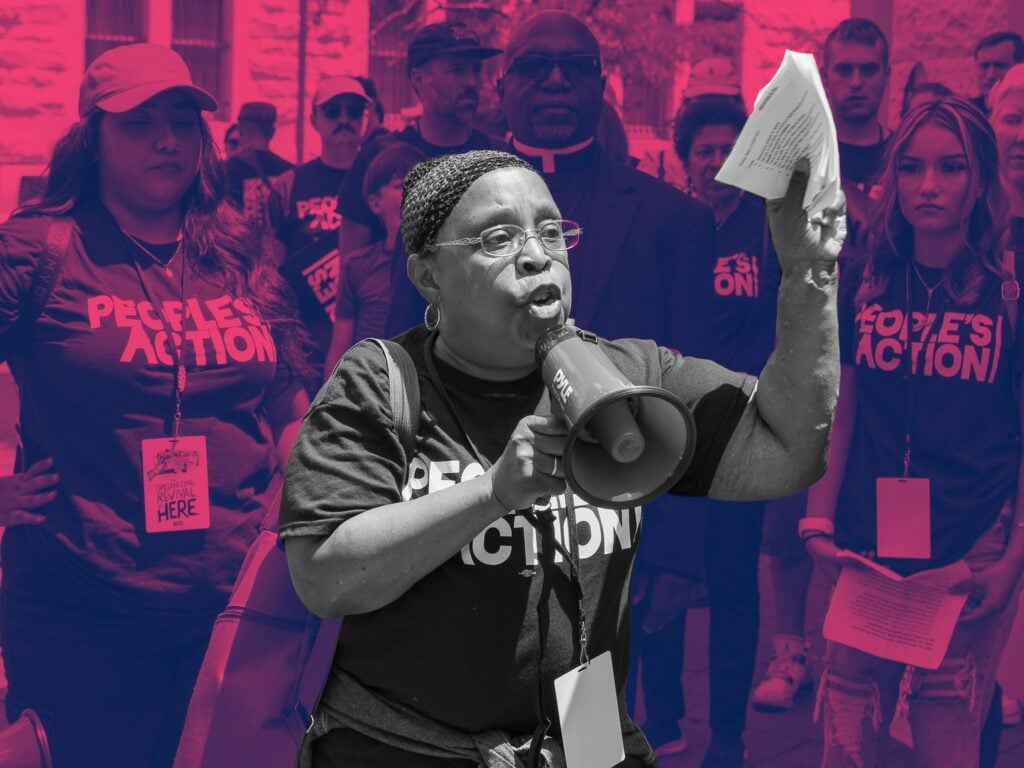For the US Left, much of last year was marked by big shifts and big gatherings, taking stock and plotting paths. Convergence first conceived of this series before Hamas attacked Israel and Israel invaded Gaza, shattering lives and upending politics. But as the shadows of war and fascism deepen, so does our need for alignment, even as it becomes more difficult to build.
To help envision how we move forward, we invited groups across the Left to contribute to this series in the spirit of building understanding across our movement ecosystems. Much of the work to block the MAGA Right over the next year will necessarily happen in electoral campaigns, but moving towards true multiracial democracy will take long-term work on many levels, from neighborhood to national, from community- and institution-building to winning races and ballot measures, as we contest for governing power.
We asked respondents to write about ways their strategy contributes to blocking MAGA in 2024, and how their short- and long-term plans inform each other; how their strategy contributes to building leaders, members, power and capacity; and how they fit into the movement ecosystem, and coordinate and collaborate with others in their niche. The order in which contributions appear reflects different organizations’ rhythms of work, rather than a political assessment by Convergence. This is the third article in the series; you can read the first two installments here and here.
This is an invitation to my friends, colleagues, and movement family to join the Organizing Revival. It is also a challenge to the entire ecosystem to center people-powered organizing. This is especially important amidst the urgency of defeating rising authoritarianism and winning elections.
The community and worker organizing sector has won major electoral and issue victories over the last several years. But we will need far more power to win the bigger fights that lie ahead. Constant mobilization, transactional campaigning, and a lack of emphasis on deep leadership development have weakened our power on the ground. In the field, there is universal agreement that we need a sustained focus on identifying, recruiting, and developing new staff, members, and leaders, and especially developing organizing skills among them. We all need to prioritize base-building and leadership development. There is also a hunger to continue our work of building a Bigger We that meets people where they’re at and then brings them along with us. The Organizing Revival is this return to more grounded ways of communicating and campaigning.
I often try to imagine what it will be like in 10 years. I imagine victories, of course. The feelings that surprise me most are calm and contentment, as I see the accumulated power that comes from patient, disciplined, deep, and transformative organizing. I imagine how the Organizing Revival helped us shift the landscape of democracy in states to be more fair and inclusive, which set the stage for passing federal voting rights and labor organizing reforms. This virtuous circle enabled state and federal policy breakthroughs. In my vision, this bottom-up approach worked better than top-down, elite strategies to effect change, and created a new policy-making majority force in American politics. Our hallmarks were cross-movement collaboration, trust, and accountability to our members. Then I come back to reality and the work of mapping the path forward to this dream, because I want to achieve it with all of my heart and soul.
In the Antidote to Authoritarianism: How An Organizing Revival Can Build a Multiracial Pluralistic Democracy and an Inclusive Economy and Democracy’s Antidote to Authoritarianism: An Organizing Revival we describe the Organizing Revival as a movement to reground ourselves in relational, transformative, power-based community and worker organizing. This organizing is an end and a means—it builds community and democracy and makes people feel powerful and whole. Many groups are doing this work right now, and it is supercharging their electoral programs at the same time that it is building power.
- Illinois: First in the nation to end cash bail: On September 18, Illinois became the first state in the nation to end cash bail. Other states have sought to limit this widespread practice, which forces people to pay for release from jail while they await trial. Our members showed the power of organizing and movement co-governance with a win that helps the state put public safety over private profit.
- Washington: Power-Building Alignment: For the past year, ONE America and Washington CAN have been working together to develop the WA State Power-Building Table with 7 other organizations. This September, they doubled down on this investment with the launch of the Campaign Leadership School with trainings for 40 people.
- Pennsylvania: Whole-Home Repairs Victory Using Federal Infrastructure Funds: Pennsylvania Stands Up partnered with state legislators Sara Innamorato and Nikil Saval to launch Whole-Home Repairs, a bipartisan program that channels $125 million in federal funds to households with credits of up to $50,000 so they can fix their roofs, install energy-efficient furnaces and weatherproof homes. Making these repairs helps people lower utility bills, qualify for renewable energy credits, and reduce greenhouse gas emissions.
- And more from Indiana, Iowa, Maryland, Massachusetts, North Carolina, and Washington.
The key to unlocking our vision and plan for the next 10 years, on the path to our 40-year long-term agenda, is unprecedented collaboration in the community and worker organizing movement. Unprecedented collaboration is not just about making each separate network and organization better (though that is important); it unlocks the potential for strategic alignment and shared movement infrastructure that will help independent as well as networked organizations build and wield power more effectively across issues, geographies, and constituencies. This is how we will defeat and out-compete the corporate-conservative and authoritarian movements for the hearts and minds of America.
A combination of factors has made unprecedented collaboration possible now: generational change at organizing networks and intermediaries that leave the old beefs behind; the rise of BIPOC, women, LGBTQIA+, and working-class leaders and their intersectional perspectives; the urgency of rising authoritarianism and polycrises; and plain old being sick of losing.
Strategic alignment comes from building a shared analysis of the problems and root causes of polycrises, a vision and long-term agenda of what we can achieve in alignment, power analysis of ourselves and our opponents that sharpens our division of labor, power-building that can construct multi-racial majorities, and then codifying this alignment in organizational and alliance-based power plans. This is a base of people-power that can serve as a durable force to win and protect victories once we create the conditions for structural change. We can do this together by:
- Reviving the practice of building power that centers the virtuous cycle of developing volunteer leaders who can organize others, developing lead organizers who can train new organizers, and robust training programs.
- Using the Bigger We framework to construct multi-racial majorities, then investing in base-building with a division of labor vs. competition over the same people and places.
- An ideological framework that builds shared analysis on root causes and worldview with a vision of a future where all people thrive.
- Disciplined, ongoing, bottom-up power analysis that leads to meaningful stepping-stone campaign victories that shift power and money from corporations and the wealthy to the people and the public.
- Shifting the political and narrative landscape from one defined by the corporate-conservative and authoritarian movements to one more fair and inclusive—because we know that organized multi-racial majorities can win almost any fight on level terrain.
Shared movement infrastructure is possible with unprecedented collaboration. The Movement Cooperative is a good example. Imagine if we created more shared infrastructure on:
- Base-building experiments, innovation and learning.
- Recruitment and development of new organizers into lead organizers, and ongoing support for lead organizers to stay in the craft.
- Construction of a movement-owned national campaign center.
- Creation of a shared long-term agenda and mid-range plan for the field.
- Construction of a shared, rolling internal and external power analysis of states.
- Scalable and collaborative digital operations.
- Collaborative experiments and learning in independent resource generation.
- Development of new evaluation criteria and metrics for organizations and donors.
- A collective drumbeat of stories about the power and impact of organizing.
- Reorganize existing policy shops, research institutions, narrative groups, think tanks and other elements of the progressive ecosystem around power-building organizing.
We see three enormous opportunities for unprecedented collaboration in 2024. First, we can advance our long-term agenda by supporting state and local electoral work that centers power-building and elects working people from the leadership of grassroots organizations. This can also advance issue campaigns and build movement co-governance structures that hold elected officials accountable to working-class communities.
Second, state and local implementation of federal infrastructure funding—like Whole-Home Repairs in Pennsylvania—is the biggest current opportunity to drive collaboration, power-building, and tangible economic and climate justice victories. We need people to “own” these victories and tell the story of how democracy and organizing improved their lives and communities.
Third, we have to change the story about the root causes and solutions of the problems that working people face. We have to build relationships across differences and move constituencies into multi-racial majorities. This is essential to changing the story about immigration, migration, and race—as internal climate migration ramps up for 50 million Americans from coastal, drought, and storm-ravaged areas toward New England and the Upper Midwest. This sharpens the need for increased organizing in rural communities and small towns in both inflow and outflow states.
The Organizing Revival is a growing collective of more than a dozen community and worker organizing networks. The groups that endorsed the Antidote to Authoritarianism white paper are a who’s who of the most effective and innovative organizing happening today: 22nd Century Initiative, Action Lab, Alliance for a Just Society, Center for Popular Democracy, Collaborative for Jewish Organizing, Community Change, Faith in Action, Gamaliel, Midwest Academy, National Committee for Responsive Philanthropy, National Domestic Workers Alliance, Native Organizers Alliance, PowerSwitch Action, Social & Economic Justice Leaders Project, and Working Families Party. We invite you to join us!
Featured image by Rae Breaux/People’s Action
Did you enjoy this article?
We're in the middle of our annual fund drive, and this year we're building our own internal infrastructure for subscriptions, meaning more of every dollar pledged goes to fulfilling our mission. Subscribe today to support our work and be a part of Convergence's next evolution.

